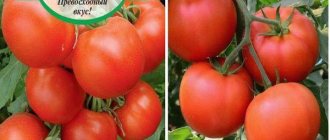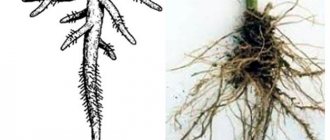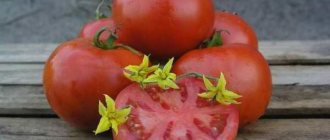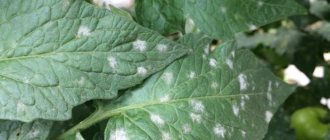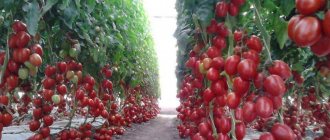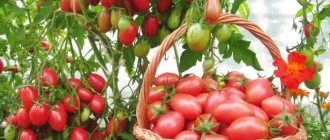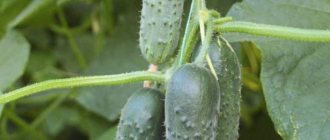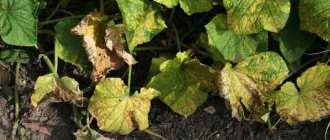Tomatoes without seedlings for open ground. The selection includes low-growing ones - up to 60 cm, with fruits of 50-300 g, in different forms for pickling and salads. Descriptions with photos.
It sounds fantastic, but I think it’s possible to sow tomatoes in the ground in the spring and harvest the red fruits in early August. This happened to me once. True, I sowed random varieties, so there were only a few ripe fruits.
My region is Western Siberia, Kuzbass.
What if the tomatoes are all from the same series, cold-resistant, early, and consistently productive?
Why do I need tomatoes without seedlings?
The goal is to prove to myself and show readers and fellow countrymen that tomatoes without seedlings are possible, and not just any kind, but tasty and even of normal size.
I doubt it, and that adds excitement. I really want to reduce the population of seedlings on windowsills.
I already had this experience, I sowed it in a greenhouse at the end of April, but random varieties, photo by the author
The “Tomatoes without seedlings” series includes more than 20 varieties. There is something to choose from based on ripening time, bush height, fruit size, shape, and taste.
Open ground and greenhouse
Isn’t it easier to grow tomatoes in a greenhouse than to take risks and create difficulties for yourself by growing plants in open ground?
Indeed, it's easier. But, as in any business, there are pros and cons.
- Fruits from open ground are tastier. Coming from the tropics of South America, tomatoes are one of the most heat-loving and “sun-loving” garden plants. They don't just prefer the sun. They vitally need it - direct sun, and the sunniest place on the site. Only in this case, the fruits grown and ripened on the bushes will be the most delicious!
- Saving scarce and expensive space in the greenhouse. After all, there are so many plants that, in open ground conditions, simply cannot produce any harvest at all, unlike tomatoes!
- Possibility to grow many different varieties. The area of the plot is always much larger than the area of even the largest greenhouse. And on a large plot there will definitely be not one, but several places that are ideal for tomatoes. And you can grow as many different varieties as you want! How many bushes will fit in the greenhouse? In any case, significantly less than in several beds.
- More bushes - less maintenance. As a rule, low-growing and medium-growing varieties of tomatoes of early and medium ripening are chosen for open ground. They are not as demanding to care for as tall, vine-like varieties for protected soil. And they are simply indispensable for those gardeners who are on the site only on weekends: after all, plants do not need to be ventilated outside, they are not so hot in the heat, they will not dry out without regular watering. Some varieties don't even need to be pinched.
I didn’t choose all the varieties from the “Tomatoes without seedlings” series
From the entire series, I chose those that, in my opinion, are more likely to bear fruit, and ripe ones at that.
These are the varieties:
- with a low bush - up to 60 cm, I think the less time it takes for the stem to grow, the sooner the fruits will appear;
- with a ripening period of up to 100 days;
- resistant to cold and temperature changes.
There are also varieties in the series that are one meter tall, with a ripening period of 110 days. But, probably, they are for sowing in the soil of warm regions or in a greenhouse. I want to work immediately for a positive result in the open ground.
Requirements for varieties
What are the requirements for the best varieties of tomatoes for open ground?
First of all, they must be hardy. This concept includes both the variety’s resistance to cold and adverse weather conditions (wind, rain), and complex resistance to diseases and pests.
In second place is early maturity. Even a novice gardener can grow varieties that begin to ripen quickly after 75-90 days. And they will certainly have time to grow even in a cold and rainy summer.
In third place, oddly enough, taste should be placed. For a family garden, this is much more important than outstanding yield with mediocre taste! But taste is such a subjective assessment that you cannot be guided by other people’s advice, but must rely solely on your own experience - the more different varieties you can taste, the better!
Finally, it is advisable to focus on zoned varieties. Although now this is no longer as relevant as it was in previous years, when the choice of varieties and hybrids was hundreds of times smaller.
Moskvich is my very old friend
The only variety from the entire “Tomatoes without seedlings” series that I have grown for more than one year. I really liked the compact bushes, on strong stems, strewn with red fruits. The tomatoes ripened on bushes in Siberia and were small in size - 50 g.
My Moskvich did not require supports or stepsons. I grew it through seedlings, which, by the way, did not grow on the windowsill. Now I’ll try to sow it in the ground, under temporary cover.
Moskvich tomatoes, photo by the author
Characteristics of Moskvich:
- the height of the bush is 30-45 cm, it is standard;
- fetal weight - 40-60 g, the first more than 100 g;
- high fruit set in unfavorable conditions;
- friendly formation of the harvest.
I haven’t grown other varieties from the selection, I’m just planning to, so the photo is from the Internet. Subscribe so you don't miss my photo report with the results of growing.
The largest varieties of tomatoes
Not only the high harvest, but also the record-breaking large fruits make the neighbors in the area envious. In addition, if you are planning to prepare tomato juice, sauce, paste or ketchup for the winter, it is easier to produce them from large tomatoes.
Bull's heart
One of the most delicious universal early-ripening varieties, the fruits of which can reach enormous sizes: their weight can exceed 500 g. The pulp does not contain hard fibers, there are few seeds in tomatoes, the skin of the fruit is thin, but the fruits are transported well. The bush is tall and needs support.
In the photo: Tomato variety Bull's heart
King of Kings
A universal mid-early tall and high-yielding hybrid tomato with round red fruits weighing up to 1 kg. The fruits do not form seeds; in conditions of high humidity they can crack, but the taste of the fruits of this variety is excellent.
In the photo: Tomato variety King of Kings
Honey saved
A tall, universal, mid-season variety with sweet orange fruits weighing up to 200 grams or more. The fruits are stored well and do not lose their commercial quality during transportation.
In the photo: Tomato variety Honey Spas
The Alsou and Orange varieties are also distinguished by their large fruits. And you will learn about which varieties of tomatoes that do not require pinching can be grown in the middle zone from the following video:
Betalux - small but remote
The characteristics are approximately the same as those of the Moskvich. The bush is standard, the stem is strong. The variety is suitable for cultivation in regions of unsustainable agriculture.
The height of the bush is 40-50 cm, but the fruits are large - up to 120 g, flat-round, tasty.
I can’t wait to drive Moskvich and Betalux to compare and choose which is better.
Spring of the North - tomatoes without seedlings with pink and large fruits
This early ripening small fruit, 40-60 cm tall, produces even larger fruits - 210-350 g. They are pink, flat-round, fleshy, tasty. Suitable for salads and making juices.
It would be nice to tame such a seedless variety.
It is written that the Spring of the North requires formation.
Also in the description of non-seedling varieties there is a recommendation to plant shoots to form an early harvest. This is logical: fewer stepsons, more energy for the fruits, they will be larger.
Summer resident - the variety is consistently productive
The variety captivated us with such characteristics as:
- unpretentiousness, can be grown even on the balcony;
- high tying even in cool and cloudy weather;
- resistance to stress due to unfavorable growing conditions;
- stable yield.
At the same time, the bush is standard 50-60 cm tall, and the fruits are fleshy and large - 130-180 g.
Variety "Chukchi mischievous"
Cold-resistant, ultra-early, large-fruited hybrid for open and protected ground. The period from germination to ripening is 91-94 days. The plant is determinate, 55-60 cm high. There are 4-6 fruits in a cluster. The fruits are round or flat-round, smooth, red, without a green spot at the stalk, dense, fleshy, sweet, of very high taste. Fruit weight up to 210 g. Perfect for canning, salads, and assorted vegetables. It is resistant to late blight.
And after that, a few more varieties in the photo:
I am sure that these recommendations will not be superfluous. Let the summer please you with harvests!
(Co-author of the site Tatyana)
SHARE LINK:
4 2
4 2
Irina - very early with a high content of lycopene and vitamin C
Lycopene is found in all tomatoes, but not all in high doses. In the body it works as an antioxidant and slows down cell aging. But it is better not to overuse tomato juice Irina, there may be negative consequences, for example, skin pigmentation.
The increased content of vitamin C will have a tonic and general strengthening effect. But it also means that the tomatoes will be sour. So those with a sweet tooth may not like the variety.
And I love tomatoes with classic color and taste. They are indispensable for borscht, cabbage soup, and meat sauces.
Irina's bush grows up to 60 cm and requires pinching. The fruits grow up to 160 g.
This is a very early and cold-resistant variety. The first fruits begin to sing already 85 days after emergence.
Success - red cream with a spout
The harvest ripens after 83 days from germination. Standard bush. The fruits are plum-shaped with a spout. They are dense and tasty, with a high content of dry matter. Weight - 60-70 g.
I really wanted to cook tomatoes in their own juice. I haven't made such preparations for a long time.
Like all the tomatoes in the selection, Success is consistently productive, regardless of the vagaries of the weather.
Subarctic - super early ripening, first raceme above 5-6 leaves
Ripening begins 82 days after germination. The bush is low - 40-45 cm, the tomatoes are small - 40-50 g. But thanks to their early ripening and resistance to bad weather, they all ripen on the bushes in any summer.
The yield of the harvest is friendly, as a result, the tomato successfully escapes late blight and manages to bear fruit before it becomes rampant.
Seedless tomato culture
Seeds of ultra-early ripening cold-resistant tomato varieties are able to germinate at relatively low temperatures of +7-10 °C. This is definitely worth taking advantage of! And try to grow a heat-loving tomato in a seedless culture, at least as an experiment in a small area.
In general terms it looks like this:
- choose an area with fertile soil, maximally protected from the wind
- dig up the ground, carefully removing all weeds
- add humus, compost, mineral fertilizers
- when determining sowing dates, they are guided by the beginning of cherry blossoms
- if the soil is loose, roll it before sowing
- sow selected calibrated seeds (sprouted or dry - but the latter will take much longer to germinate)
- water, cover the crops with non-woven material
Caring for crops consists of ventilation, watering and mandatory timely weeding.
With this method, it is possible to harvest fewer ripe tomatoes, but the total yield will be the same as when grown through seedlings.
The undoubted advantage is that the plants grow strong, are resistant to bad weather, do not get sick, have a powerful root system and practically do not need watering. And most importantly, it frees up scarce space on the window sills. It's worth the risk!
